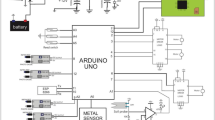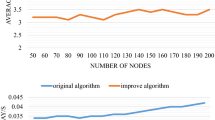Abstract
Nowadays, modern industries generate their energy by using renewable solar. The rapid increase in photovoltaic (PV) module installations provides a better energy conversion, but their life cycle is a major concern. This research paper focuses on the recycling process for solar PV modules using the Internet of Things in industries. The smart bin with the Internet of Things (IoT) utilizes a machine learning approach to collect solar waste. The proposed smart bin uses k-Nearest Neighbor’s algorithm (k-NN) and Long Short-Term Memory (LSTM), a network-based learning algorithm. These algorithms are useful in updating the level of the bin via alert messages. It also helps in identifying the type of waste material. The k-NN algorithm provides 83% accuracy in predicting the bin level in a real-time testing environment. The smart dust bin classifies the waste materials, and notifies its level to the collection center through the IoT platform when the level reaches a prescribed threshold, the signal corresponding to the level is passed to the common waste collection unit. IoT is connected to Cloud Server. It helps to predict the level of the smart bin. Delay is introduced in the order of 3–8 s while the alert message is sent to the common waste collection unit. The system monitors the smart bin levels and sends the notifications to alert and initiate the collection unit. Real-time mobile app monitors the bin’s level and location. The cloud IoT analytics analyze the solar e-waste in a different locations in industries.The proposed system works better and provides accurate results by using machine learning approach.














Similar content being viewed by others
Data availability
All data analyzed during this work are included in this published article.
References
Ali T, Irfan M, Alwadie AS, Glowacz A (2020) IoT-based smart waste bin monitoring and municipal solid waste management system for smart cities. Arab J Sci Eng 45:10185–10198
Anitha A (2017) Garbage monitoring system using IoT. Paper presented at the IOP Conference Series: Materials Science and Engineering
Bharadwaj B, Kumudha M, Chaithra G (2017) Automation of Smart waste management using IoT to support “Swachh Bharat Abhiyan”-a practical approach. Paper presented at the 2017 2nd International Conference on Computing and Communications Technologies (ICCCT)
Bobulski J, Kubanek M (2019) Waste classification system using image processing and convolutional neural networks. Paper presented at the International Work-Conference on Artificial Neural Networks
Chakankar M, Su CH, Hocheng H (2019) Leaching of metals from end-of-life solar cells. Environ Sci Pollut Res 26(29):29524–29531
Dev A, Jasrotia M, Nadaf M, Shah R (2016) IoT based smart garbage detection system. Int Res J Eng Technol 3(12)
Devi MP, Raja GB, Gowrishankar V, Sathya T (2020) IoMT-based smart diagnostic/therapeutic kit for pandemic patients. Internet of Medical Things for Smart Healthcare (pp. 141–165): Springer
Draz U, Ali T, Khan JA, Majid M, Yasin S (2017) A real-time smart dumpsters monitoring and garbage collection system. Paper presented at the 2017 Fifth International Conference on Aerospace Science & Engineering (ICASE)
Gollakota AR, Gautam S, Shu C-M (2020) Inconsistencies of e-waste management in developing nations–Facts and plausible solutions. J Environ Manag 261:110234
Huiyu LOOG, Kim S-H (2019) Automatic classifications and recognition for recycled garbage by utilizing deep learning technology. Paper presented at the Proceedings of the 2019 7th International Conference on Information Technology: IoT and Smart City
Hussain A, Draz U, Ali T, Tariq S, Irfan M, Glowacz A, Rahman S (2020) Waste management and prediction of air pollutants using IoT and machine learning approach. Energies 13(15):3930
Jain A, Bagherwal R (2017) Design and implementation of a smart solid waste monitoring and collection system based on Internet of Things. Paper presented at the 2017 8th International Conference on Computing, Communication and Networking Technologies (ICCCNT)
Jumin E, Basaruddin FB, Yusoff YBM, Latif SD, Ahmed AN (2021) Solar radiation prediction using boosted decision tree regression model: a case study in Malaysia. Environ Sci Pollut Res 28(21):26571–26583
Kim S, Jeong B (2016) Closed-loop supply chain planning model for a photovoltaic system manufacturer with internal and external recycling. Sustainability 8(7):596
Lee J-K, Lee J-S, Ahn Y-S et al (2018) Simple pretreatment processes for successful reclamation and remanufacturing of crystalline silicon solar cells. Prog Photovolt Res Appl 26:179–187. https://doi.org/10.1002/pip.2963
Liu Q, Zhang B, Sun H, Guan Y, Zhao L (2010) A novel k-means clustering algorithm based on positive examples and careful seeding. Paper presented at the 2010 International Conference on Computational and Information Sciences
Liu B, Song C, Wang Q, Wang Y (2021) Forecasting of China’s solar PV industry installed capacity and analyzing of employment effect: based on GRA-BiLSTM model. Environ Sci Pollut Res, 1–17
Longhi S, Marzioni D, Alidori E, Di Buo G, Prist M, Grisostomi M, Pirro M (2012) Solid waste management architecture using wireless sensor network technology. Paper presented at the 2012 5th international conference on new technologies, mobility and security (NTMS)
Memon SK, Shaikh FK, Mahoto NA, Memon AA (2019) IoT based smart garbage monitoring & collection system using WeMos & Ultrasonic sensors. Paper presented at the 2019 2nd International Conference on Computing, Mathematics and Engineering Technologies (iCoMET)
Pan P, Lai J, Chen G, Li J, Zhou M, Ren H (2018) An intelligent garbage bin based on NB-IOT research mode. Paper presented at the 2018 IEEE International Conference of Safety Produce Informatization (IICSPI)
Rahman MW, Islam R, Hasan A, Bithi NI, Hasan MM, Rahman MM (2020) Intelligent waste management system using deep learning with IoT. J King Saud Univ Comput Inf Sci
Rashedi A, Khanam T (2020) Life cycle assessment of most widely adopted solar photovoltaic energy technologies by mid-point and end-point indicators of ReCiPe method. Environ Sci Pollut Res 27:29075–29090
Samann FE (2017) The design and implementation of smart trash bin. Acad J Nawroz Univ 6(3):141–148
Shokrzade A, Ramezani M, Tab FA, Mohammad MA (2021) A novel extreme learning machine based kNN classification method for dealing with big data. Expert Systems with Applications, 115293
Sreelakshmi K, Akarsh S, Vinayakumar R, Soman K (2019) Capsule neural networks and visualization for segregation of plastic and non-plastic wastes. Paper presented at the 2019 5th international conference on advanced computing & communication systems (ICACCS)
Sunny MSH, Dipta DR, Hossain S, Faruque HMR, Hossain E (2019) Design of a convolutional neural network based smart waste disposal system. Paper presented at the 2019 1st International Conference on Advances in Science, Engineering and Robotics Technology (ICASERT)
Wijaya AS, Zainuddin Z, Niswar M (2017) Design a smart waste bin for smart waste management. Paper presented at the 2017 5th International Conference on Instrumentation, Control, and Automation (ICA)
Wu Y, Sun L, Sun X, Wang B (2021) A hybrid XGBoost-ISSA-LSTM model for accurate short-term and long-term dissolved oxygen prediction in ponds. Environ Sci Pollut Res, 1–18
Author information
Authors and Affiliations
Contributions
Dr. M. Parimala Devi and Ms. T. Sathya made substantial contributions to the conception and design of the manuscript. Mr. G. Boopathi Raja, Dr. V. Gowrishankar, and Dr. S. Nithya drafted the manuscript and revised it critically for important intellectual content. All authors reviewed the final version of the manuscript.
Corresponding author
Ethics declarations
Ethics approval and consent to participate
Not applicable.
Consent for publication
Not applicable.
Conflict of interest
The authors declare no competing interests.
Additional information
Responsible Editor: Philippe Garrigues
Publisher's note
Springer Nature remains neutral with regard to jurisdictional claims in published maps and institutional affiliations.
Conventional methods like c-Si and thin-film technologies are low-cost methods for recycling solar cells. Still, the other methodologies are to be developed and so that they should match the industrial constraints.
Rights and permissions
About this article
Cite this article
Muthusamy, P.D., Velusamy, G., Thandavan, S. et al. Industrial Internet of things-based solar photo voltaic cell waste management in next generation industries. Environ Sci Pollut Res 29, 35542–35556 (2022). https://doi.org/10.1007/s11356-022-19411-8
Received:
Accepted:
Published:
Issue Date:
DOI: https://doi.org/10.1007/s11356-022-19411-8




